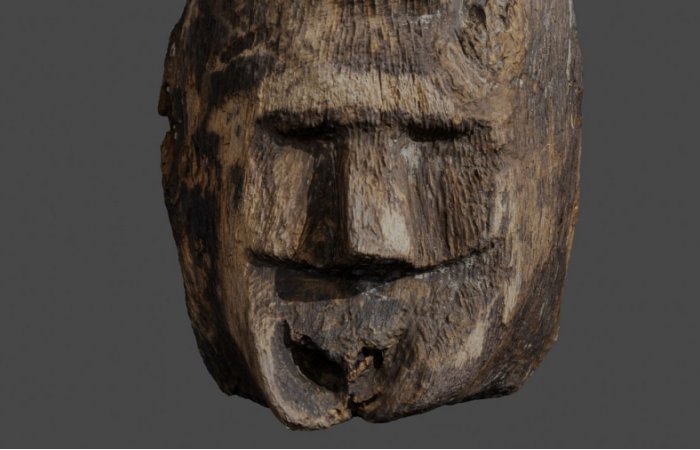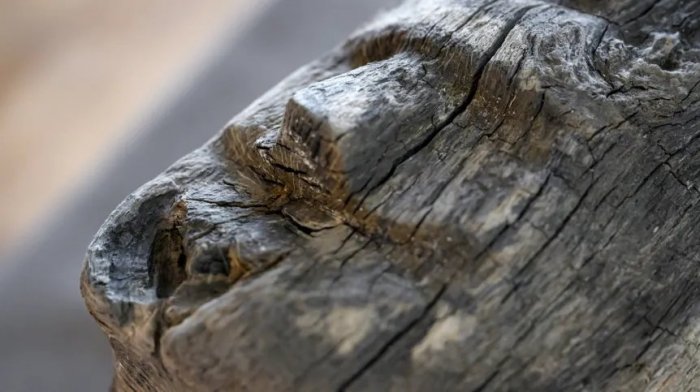Conny Waters – AncientPages.com – Last year, during underwater research in Lake Lednica (Gniezno County, Greater Poland Voivodeship), Polish archaeologists from Nicolaus Copernicus University discovered a fragment of defensive ramparts.
The face has very realistic features: the eyes, nose, mouth, distinctive chin and oval form of the head are visible. Image credit: Mateusz Popek, the Centre for Underwater Archaeology at Nicolaus Copernicus University
The artifact is decorated with a carved image of a face, and according to researchers, it is unique due to its distinctive nature.
Ostrów Lednicki is the principal island on the lake. Once, in this area, there was one of the most important fortresses of the early Piast state, the first historical ruling dynasty of Poland. The site is renowned for hosting one of Poland’s oldest palace-sacral complexes. Many researchers believe that the island was a key location where Christianity initially confronted and interacted with and influenced local religious traditions.
Today, the historical remains include powerful defensive ramparts, the Prince’s Palace, and a chapel with baptismal pools.
The found artifact is an oak beam with a preserved length of 1.34 m and a diameter of several centimeters. It is decorated with an image of a human face with very realistic features, whose forehead features a precisely made arched oval groove, giving the image an oval shape measuring approximately 13.5 by 10 cm.
Dr. Andrzej Pydyn, NCU professor, director of the Centre for Underwater Archaeology at Nicolaus Copernicus University in Toruń. Image credit: Andrzej Romański. Image source – the Centre for Underwater Archaeology at Nicolaus Copernicus University in Toruń.
The craftsmanship of the wood and the facial expression suggest that this was not merely a decorative motif. It is possible that the depiction held symbolic significance, perhaps representing divinity, a protective spirit, warding off evil forces, or a hero safeguarding the settlement’s inhabitants.
“This discovery not only evokes admiration for the craftsmanship from over a thousand years ago but also opens a fascinating discussion about the spiritual life of early medieval Slavs,” says Dr. Andrzej Pydyn, NCU professor, director of the Centre for Underwater Archaeology at Nicolaus Copernicus University in Toruń.
The analysis of the tree used to create the artifact was cut down in 967, with a margin of seven years before or eight years after that date.
Dr. Pydyn noted that archaeological works in the area of Piast Castle on Lednice Island have been conducted for more than 40 years, which is the longest excavation of this type in Poland.
He added that four years ago, during an extremely dry summer and the resulting low water level in the lake, scientists noted wooden elements in the coastal zone. Thus, they discovered fragments of ramparts and the intriguing face, which is probably associated with the symbolic, spiritual realm of the builders, and above all, the inhabitants of this castle, commented the researcher.
A structural element extracted from Lake Lednice, presented at a press conference at the Museum of the first Piasts in Lednica in Dziekanowice, on July 10, 2025. Image credit: Jakub Kaczmarczyk – PAP
Konrad Lewek, MA, from the Centre for Underwater Archaeology at Nicolaus Copernicus University, explains that in the material culture of the Slavs, figural anthropomorphic representations might have been more prevalent than indicated by the limited number of surviving artifacts.
This suggests a richer tradition of such representations than what is currently evidenced by archaeological findings.
Wood decomposes rapidly, which accounts for the survival of such objects solely under exceptional conditions, such as in wetlands or submerged environments. Consequently, the beam from Lake Lednica, impeccably preserved within the rampart landslide, represents a singular artifact of significant scientific and cultural importance.
Written by Conny Waters – AncientPages.com Staff Writer



